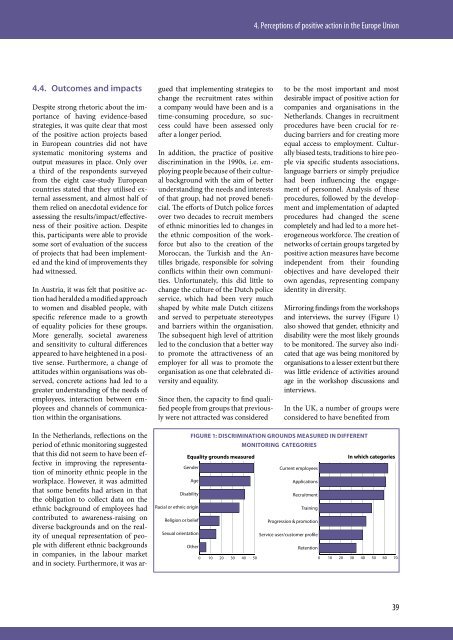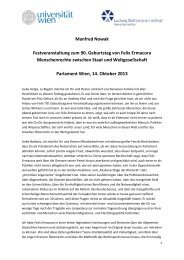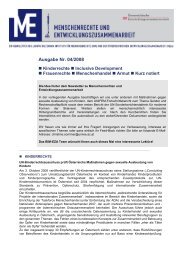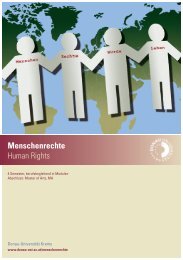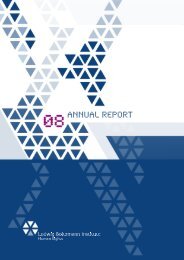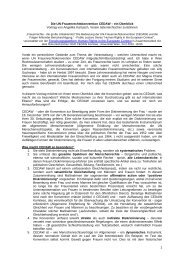International perspectives on positive action measures - European ...
International perspectives on positive action measures - European ...
International perspectives on positive action measures - European ...
Create successful ePaper yourself
Turn your PDF publications into a flip-book with our unique Google optimized e-Paper software.
4.4.<br />
Outcomes and impacts<br />
Despite str<strong>on</strong>g rhetoric about the importance<br />
of having evidence-based<br />
strategies, it was quite clear that most<br />
of the <strong>positive</strong> acti<strong>on</strong> projects based<br />
in <strong>European</strong> countries did not have<br />
systematic m<strong>on</strong>itoring systems and<br />
output <strong>measures</strong> in place. Only over<br />
a third of the resp<strong>on</strong>dents surveyed<br />
from the eight case-study <strong>European</strong><br />
countries stated that they utilised external<br />
assessment, and almost half of<br />
them relied <strong>on</strong> anecdotal evidence for<br />
assessing the results/impact/effectiveness<br />
of their <strong>positive</strong> acti<strong>on</strong>. Despite<br />
this, participants were able to provide<br />
some sort of evaluati<strong>on</strong> of the success<br />
of projects that had been implemented<br />
and the kind of improvements they<br />
had witnessed.<br />
In Austria, it was felt that <strong>positive</strong> acti<strong>on</strong><br />
had heralded a modified approach<br />
to women and disabled people, with<br />
specific reference made to a growth<br />
of equality policies for these groups.<br />
More generally, societal awareness<br />
and sensitivity to cultural differences<br />
appeared to have heightened in a <strong>positive</strong><br />
sense. Furthermore, a change of<br />
attitudes within organisati<strong>on</strong>s was observed,<br />
c<strong>on</strong>crete acti<strong>on</strong>s had led to a<br />
greater understanding of the needs of<br />
employees, interacti<strong>on</strong> between employees<br />
and channels of communicati<strong>on</strong><br />
within the organisati<strong>on</strong>s.<br />
In the Netherlands, reflecti<strong>on</strong>s <strong>on</strong> the<br />
period of ethnic m<strong>on</strong>itoring suggested<br />
that this did not seem to have been effective<br />
in improving the representati<strong>on</strong><br />
of minority ethnic people in the<br />
workplace. However, it was admitted<br />
that some benefits had arisen in that<br />
the obligati<strong>on</strong> to collect data <strong>on</strong> the<br />
ethnic background of employees had<br />
c<strong>on</strong>tributed to awareness-raising <strong>on</strong><br />
diverse backgrounds and <strong>on</strong> the reality<br />
of unequal representati<strong>on</strong> of people<br />
with different ethnic backgrounds<br />
in companies, in the labour market<br />
and in society. Furthermore, it was ar-<br />
gued that implementing strategies to<br />
change the recruitment rates within<br />
a company would have been and is a<br />
time-c<strong>on</strong>suming procedure, so success<br />
could have been assessed <strong>on</strong>ly<br />
after a l<strong>on</strong>ger period.<br />
In additi<strong>on</strong>, the practice of <strong>positive</strong><br />
discriminati<strong>on</strong> in the 1990s, i.e. employing<br />
people because of their cultural<br />
background with the aim of better<br />
understanding the needs and interests<br />
of that group, had not proved beneficial.<br />
The efforts of Dutch police forces<br />
over two decades to recruit members<br />
of ethnic minorities led to changes in<br />
the ethnic compositi<strong>on</strong> of the workforce<br />
but also to the creati<strong>on</strong> of the<br />
Moroccan, the Turkish and the Antilles<br />
brigade, resp<strong>on</strong>sible for solving<br />
c<strong>on</strong>flicts within their own communities.<br />
Unfortunately, this did little to<br />
change the culture of the Dutch police<br />
service, which had been very much<br />
shaped by white male Dutch citizens<br />
and served to perpetuate stereotypes<br />
and barriers within the organisati<strong>on</strong>.<br />
The subsequent high level of attriti<strong>on</strong><br />
led to the c<strong>on</strong>clusi<strong>on</strong> that a better way<br />
to promote the attractiveness of an<br />
employer for all was to promote the<br />
organisati<strong>on</strong> as <strong>on</strong>e that celebrated diversity<br />
and equality.<br />
Since then, the capacity to find qualified<br />
people from groups that previous-<br />
ly were not attracted was c<strong>on</strong>sidered<br />
Disability<br />
Racial or ethnic origin<br />
Religi<strong>on</strong> or belief<br />
Sexual orientati<strong>on</strong><br />
4. Percepti<strong>on</strong>s of <strong>positive</strong> acti<strong>on</strong> in the Europe Uni<strong>on</strong><br />
to be the most important and most<br />
desirable impact of <strong>positive</strong> acti<strong>on</strong> for<br />
companies and organisati<strong>on</strong>s in the<br />
Netherlands. Changes in recruitment<br />
procedures have been crucial for reducing<br />
barriers and for creating more<br />
equal access to employment. Culturally<br />
biased tests, traditi<strong>on</strong>s to hire people<br />
via specific students associati<strong>on</strong>s,<br />
language barriers or simply prejudice<br />
had been influencing the engagement<br />
of pers<strong>on</strong>nel. Analysis of these<br />
procedures, followed by the development<br />
and implementati<strong>on</strong> of adapted<br />
procedures had changed the scene<br />
completely and had led to a more heterogeneous<br />
workforce. The creati<strong>on</strong> of<br />
networks of certain groups targeted by<br />
<strong>positive</strong> acti<strong>on</strong> <strong>measures</strong> have become<br />
independent from their founding<br />
objectives and have developed their<br />
own agendas, representing company<br />
identity in diversity.<br />
Mirroring findings from the workshops<br />
and interviews, the survey (Figure 1)<br />
also showed that gender, ethnicity and<br />
disability were the most likely grounds<br />
to be m<strong>on</strong>itored. The survey also indicated<br />
that age was being m<strong>on</strong>itored by<br />
organisati<strong>on</strong>s to a lesser extent but there<br />
was little evidence of activities around<br />
age in the workshop discussi<strong>on</strong>s and<br />
interviews.<br />
In the UK, a number of groups were<br />
c<strong>on</strong>sidered to have benefited from<br />
FIGURE 1: DISCRIMINATION GROUNDS MEASURED IN DIFFERENT<br />
Gender<br />
Age<br />
Other<br />
0 10 20 30 40 50<br />
MONITORING CATEGORIES<br />
Equality grounds measured In which categories<br />
Current employees<br />
Applicati<strong>on</strong>s<br />
Recruitment<br />
Training<br />
Progressi<strong>on</strong> & promoti<strong>on</strong><br />
Service user/customer pro�le<br />
Retenti<strong>on</strong><br />
0 10 20 30 40 50 60 70<br />
39


